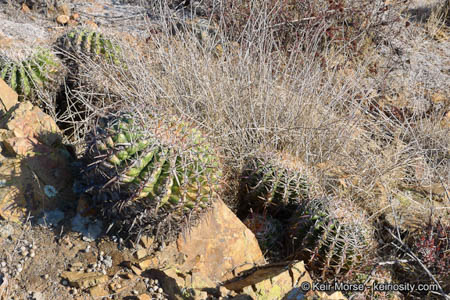In a new study published in Global Change Biology, a team of 16 scientists led by U.S. Geological Survey ecologist Michael Osland described how warming winters are allowing some tropical plants and animals to replace temperate communities across the eight southernmost U.S. states. UC Santa Cruz Environmental Studies Professor Michael Loik was a coauthor on the paper, and his contributions honed in on the impacts for plant communities in coastal California and in deserts across California and Arizona.
In particular, Loik’s work focuses on how freezing affects plants on a cellular level. Under normal conditions, winter freezes are a major environmental stressor that limits where some plants and animals can survive and reproduce. This helps to define the natural geographic range of each species. But because of climate change, winters in many regions are getting warmer, on average, with fewer days of freezing temperatures. This can lead to major ecological changes.
“What this might do is allow plants and animals to expand their habitat and their range or distribution because they no longer have that freezing limit,” Loik said. “In some cases, those species might be problematic as invasive species. In other cases, it might be native species in California or Arizona, or along the U.S. border, that move northwards or to higher elevations.”
The paper examined these effects for plants and animals across California, Arizona, New Mexico, Texas, Florida, Alabama, Mississippi, and Louisiana. In that process, the authors also analyzed changes in the frequency and intensity of extreme cold snaps in San Francisco, Tucson, New Orleans, and Tampa using temperature records stretching back to the 1940s.
The decline in the number of days with freezing temperatures was most apparent for San Francisco. Prior to 1980, most winters in San Francisco had several days each year with freezing temperatures, and some years even had about two weeks worth of subfreezing days. But since the ‘80s, there have been only 14 days with subzero temperatures.
Reduced freezes will likely mean increased potential for the spread of nonnative invasive grasses that fuel wildfires across California and other western states. Invasive tropical plants also compete with native temperate species for resources and habitat. But some cold-sensitive native plants may expand their ranges too.
In California, coastal species rely on the moderating effects of the Pacific Ocean, which keeps temperatures cooler in the summertime and warmer in the winter. As winter temperatures warm across the state, these plants may be able to venture farther inland without risking a freeze.
The coastal barrel cactus is one example from the paper of a rare plant that could potentially increase its range in California under warmer conditions. The saguaro cactus may do the same in Arizona.
But Loik cautions that the ability of any species to successfully migrate in response to climate change is complex, and success is far from guaranteed. Physical barriers like topography or urban development can prevent migration, and in many parts of the West, drought may also play a limiting role.
“There are these surprises that come up, where species are compelled to move, but other factors or processes get in the way or complicate things and preclude them from being able to do that,” Loik said.
The study’s authors suggest that modeling efforts could further explore how lengthening intervals between cold snaps might affect plant and animal communities. Laboratory studies could also help researchers learn how tropical species adapt to extreme conditions, and a scientific “rapid response” network could study future cold snaps as they happen.
After all, while freezes are becoming less frequent, they won’t go away altogether. Loik says it’s important to remember that people, plants, and animals will still experience cold winter weather, even as our climate changes. And researchers still have much to learn about how extreme cold events help to shape our ecosystems.




